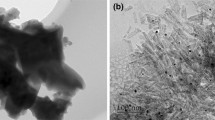Abstract
Aluminum hypophosphite (AHP) is surface modified by melamine derivative to fabricate reactive solid flame retardant (MCAHP) for polyurethane foam. MCAHP is successfully prepared and characterized by FTIR and SEM. The flame-retarded efficiency of MCAHP in PU is higher than that of AHP. It demonstrated that MCAHP has better compatibility in PU matrix compared with AHP based on the SEM observation. After surface modification, due to the reaction between MCAHP and PU matrix, crosslinking might be formed between MCAHP and PU matrix, which contributes to the excellent compatibility of MCAHP in PU matrix, and as a result, the glass transition temperature of PU/MCAHP is 4 °C higher than that of PU/AHP. The thermal behavior of PU composites is characterized by TG and TG-FTIR, and results suggest the sublimation of melamine at about 320 °C because of the decomposition of the melamine derivative. The sublimation of melamine can consume abundant heat and dilute the oxygen concentration, which is benefit for the improvement of flame retardancy.















Similar content being viewed by others
References
Tang Z, Maroto-Valer MM, Andrésen JM, Miller JW, Listemann ML, McDaniel PL, et al. Thermal degradation behavior of rigid polyurethane foams prepared with different fire retardant concentrations and blowing agents. Polymer. 2002;43(24):6471–9.
Tan SQ, Abraham T, Ference D, Macosko CW. Rigid polyurethane foams from a soybean oil-based polyol. Polymer. 2011;52(13):2840–6. doi:10.1016/j.polymer.2011.04.040.
Luo F, Wu K, Lu M, Nie S, Li X, Guan X. Thermal degradation and flame retardancy of microencapsulated ammonium polyphosphate in rigid polyurethane foam. J Therm Anal Calorim. 2015;120(2):1327–35.
Chen M-J, Chen C-R, Tan Y, Huang J-Q, Wang X-L, Chen L, Wang Y-Z. Inherently flame-retardant flexible polyurethane foam with low content of phosphorus-containing cross-linking agent. Ind Eng Chem Res. 2014;53:1160–71. doi:10.1021/ie4036753.
Morgan AB, Gilman JW. An overview of flame retardancy of polymeric materials: application, technology, and future directions. Fire Mater. 2013;37(4):259–79.
Chen X, Jiang Y, Jiao C. Synergistic effects between hollow glass microsphere and ammonium polyphosphate on flame-retardant thermoplastic polyurethane. J Therm Anal Calorim. 2014;117(2):857–66.
Gouri ME, Bachiri AE, Hegazi SE, Rafik M, Harfi AE. Thermal degradation of a reactive flame retardant based on cyclotriphosphazene and its blend with dgeba epoxy resin. Polym Degrad Stab. 2009;94(11):2101–6.
Howell BA, Uzibor J. Pentaphenyl-1,3,2-dioxaphospholane as a reactive flame retardant. J Vinyl Add Technol. 2006;12(4):192–7.
Wazarkar K, Kathalewar M, Sabnis A. Improvement in flame retardancy of polyurethane dispersions by newer reactive flame retardant. Prog Org Coat. 2015;87:75–82.
Sohn JI, Lim ST, Park SH, Choi HJ, Jhon MS. Effect of a reactive-type flame retardant on rheological and mechanical properties of PC/ABS blends. J Mater Sci. 2003;38(7):1485–91.
Ge H, Tang G, Hu W-Z, Wang B-B, Pan Y, Song L, et al. Aluminum hypophosphite microencapsulated to improve its safety and application to flame retardant polyamide 6. J Hazard Mater. 2015;294:186–94.
Zhou X, Li J, Wu YG. Synergistic effect of aluminum hypophosphite and intumescent flame retardants in polylactide. Polym Adv Technol. 2015;26(3):255–65. doi:10.1002/pat.3451.
Tang G, Wang X, Zhang R, Yang W, Hu Y, Song L, et al. Facile synthesis of lanthanum hypophosphite and its application in glass-fiber reinforced polyamide 6 as a novel flame retardant. Compos Part A Appl Sci Manuf. 2013;54:1–9. doi:10.1016/j.compositesa.2013.07.001.
Zhao HB, Liu BW, Wang XL, Chen L, Wang XL, Wang YZ. A flame-retardant-free and thermo-cross-linkable copolyester: flame-retardant and anti-dripping mode of action. Polymer. 2014;55(10):2394–403. doi:10.1016/j.polymer.2014.03.044.
Tang G, Wang X, Xing WY, Zhang P, Wang BB, Hong NN, et al. Thermal degradation and flame retardance of biobased polylactide composites based on aluminum hypophosphite. Ind Eng Chem Res. 2012;51(37):12009–16. doi:10.1021/ie3008133.
Bugajny M, Bourbigot S, Bras ML, Delobel R. The origin and nature of flame retardance in ethylene-vinyl acetate copolymers containing hostaflam AP 750. Polym Int. 1999;48(4):264–70.
Chen X, Huo L, Jiao C, Li S. TG-FTIR characterization of volatile compounds from flame retardant polyurethane foams materials. J Anal Appl Pyrolysis. 2013;100:186–91. doi:10.1016/j.jaap.2012.12.017.
Gao G, Moya S, Lichtenfeld H, Casoli A, Fiedler H, Donath E, et al. The decomposition process of melamine formaldehyde cores: the key step in the fabrication of ultrathin polyelectrolyte multilayer capsules. Macromol Mater Eng. 2001;286(6):355–61.
Wang ZZ, Lv P, Hu Y, Hu KL. Thermal degradation study of intumescent flame retardants by TG and FTIR: melamine phosphate and its mixture with pentaerythritol. J Anal Appl Pyrolysis. 2009;86(1):207–14. doi:10.1016/j.jaap.2009.06.007.
Acknowledgements
The financial supports from Guangdong Natural Science Foundation, China (Nos. 2015A030313798, 2016A030313161) and Guangdong Special Support Program-Youth Top-notch Talent (No. 2014TQ01C400) are acknowledged.
Author information
Authors and Affiliations
Corresponding author
Rights and permissions
About this article
Cite this article
Luo, F., Wu, K., Lu, M. et al. Surface modification of aluminum hypophosphite and its application for polyurethane foam composites. J Therm Anal Calorim 129, 767–775 (2017). https://doi.org/10.1007/s10973-016-5908-6
Received:
Accepted:
Published:
Issue Date:
DOI: https://doi.org/10.1007/s10973-016-5908-6



